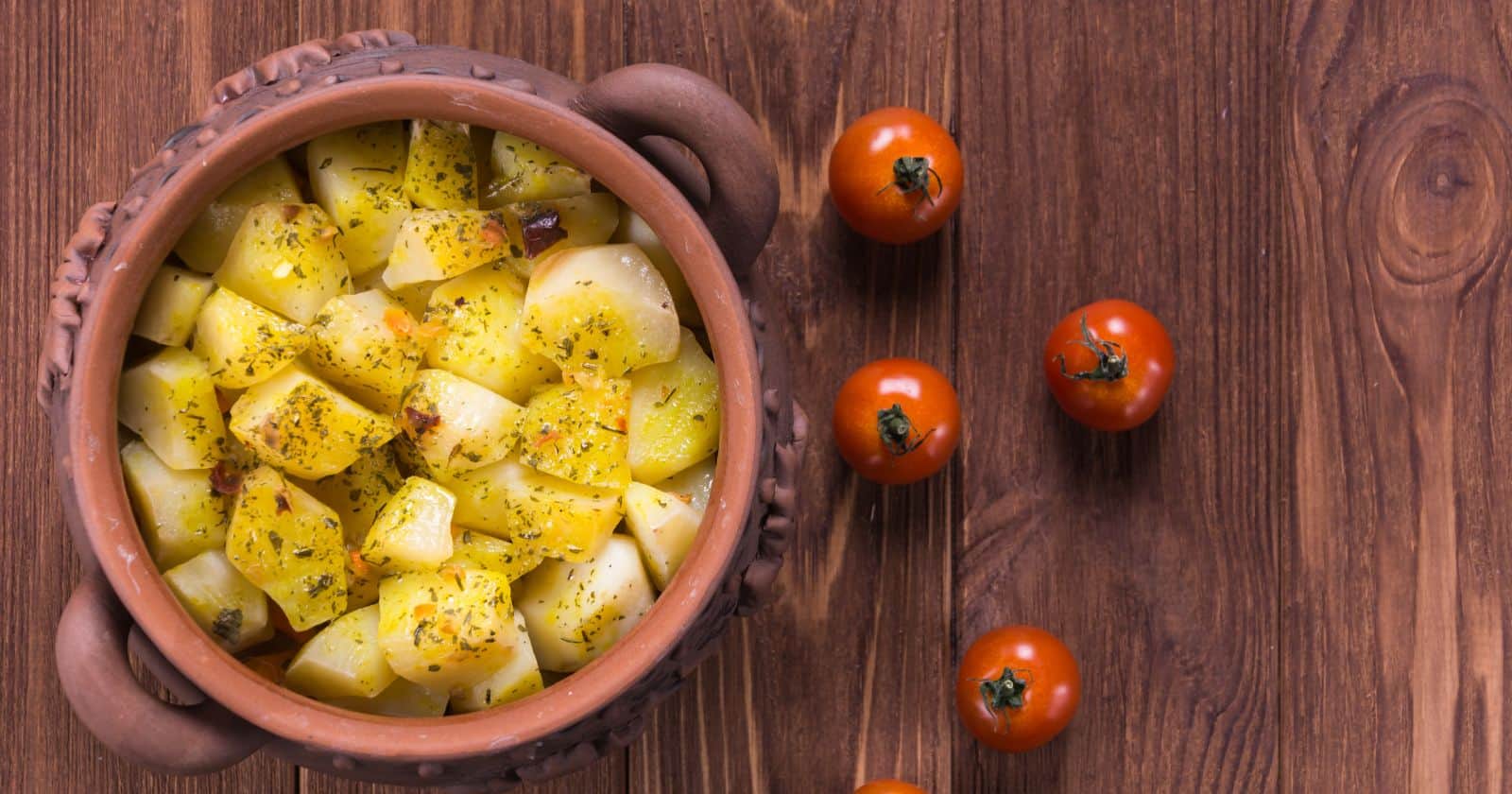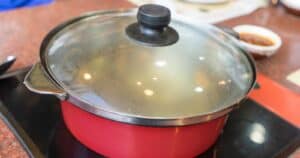Have you ever tried making a delicious hot pot meal only to have the potatoes turn into a gluey mess on the bottom of the pot? I’ve been there too. There’s nothing more frustrating than spending time prepping ingredients, waiting for the broth to simmer, and then realizing your potatoes have turned into a starchy paste. But don’t worry – with a few simple tricks, you can keep those potatoes perfectly intact and enjoying the flavors of your hot pot.
The key is understanding what causes the potatoes to stick in the first place. When you add potatoes to a hot pot, the high heat causes the starches on the outside of the potato to gelatinize, turning them into a gummy substance that adheres to the pot. To prevent this, you need to limit the potato’s exposure to high heat. Here are three easy ways to keep your spuds from sticking:
Blanch the potatoes briefly before adding them to the hot pot. A quick 30 second dip in boiling water will help set the exterior while keeping the inside fluffy. Just watch the clock to avoid overcooking.
Slice the potatoes thinly and add them late in the cooking process. Thin slices have less surface area to stick and won’t overcook as quickly. Adding them later also limits their time in the broth.
Coat the potatoes in cornstarch before cooking. The cornstarch seals and protects the exterior of the potato, preventing the starches from breaking down too much. Just sprinkle lightly and toss to coat.
With these handy tips, you can look forward to potato perfection in your next hot pot session. No more gluey globs or wasted spuds. Just tender, flavorful potatoes ready to soak up that delicious broth. Now grab your chopsticks and get ready to dip to your heart’s content!
Why Hot Pots Turn Potatoes Into Potato Paste
To stop potatoes from sticking in your hot pot, it helps to understand what causes them to turn gummy in the first place.
The culprit is the starch on the exterior of the potato. When potatoes are exposed to high heat, the starch granules swell and gelatinize. This transforms them into a sticky substance that firmly adheres to the surface of the pot.
Once this starchy paste hardens onto the bottom, it’s nearly impossible to remove. No amount of soaking or scrubbing will dissolve it. Your only option is to sadly scoop out the globby remnants of what used to be perfectly good spuds.
3 Simple Secrets to Keep Potatoes Intact
Luckily, avoiding potato-hot pot adhesion is easy when you follow these simple tricks:
1. Blanch the Potatoes First
Giving your potato chunks a quick blanch before adding them to the hot pot is an easy way to prevent sticking.
To blanch:
- Chop potatoes into 1-2 inch chunks.
- Bring a pot of salted water to a boil.
- Add potato chunks and boil for 1 minute only.
- Drain immediately and submerge in ice water to stop cooking.
This brief 30-60 second dip in boiling water will gelatinize some of the outer starches while leaving the inside tender. The potatoes will still absorb all the delicious flavors of the hot pot broth. But that quick blanch prevents the starch from fully breaking down into a gluey mess on the pot bottom.
Pro Tip: Watch the clock to avoid over-blanching. You want to par-cook the exterior only, not cook them through completely.
2. Slice Potatoes Thinly and Add Them Late
Another easy fix is to slice your potatoes into thin coins instead of chunks. Thin slices have less surface area touching the pot, lowering their sticking potential.
Adding these slices later in the cooking process also limits their exposure to the direct high heat. By the time they go in, the broth is simmering rather than rapidly boiling.
To try this method:
- Peel and slice potatoes 1/4 inch thick.
- Allow broth to simmer for 30 minutes.
- Add potato slices and cook 5-10 minutes until just tender.
The slices will cook through gently without the exterior starch over-gelatinizing and adhering to the pot.
3. Toss Potatoes in Cornstarch
Cornstarch works wonders to keep potato exteriors intact in a hot pot. The cornstarch seals and protects the surface starch granules, preventing them from breaking down too quickly.
To use cornstarch:
- Chop potatoes into 1-2 inch chunks.
- Toss gently with 1-2 tsp cornstarch until evenly coated.
- Shake off any excess then add to the hot pot as usual.
The cornstarch forms a barrier between the potatoes and the hot surface of the pot. Just be sure to use a light coating to avoid gummy results.
Other Handy Hot Pot Potato Tips
Keep these other handy tricks in mind for hot pot potato success:
- Use a non-stick pot – The slick surface gives potatoes less chance to latch on. Enameled cast iron or stainless steel work well.
- Give potatoes a head start – Add potatoes 5-10 minutes before other quick-cooking ingredients so they have time to cook through without overdoing the exterior.
- Try sweet potatoes or yams – The lower surface starch content makes them less likely to get gluey. Just peel before cooking.
- Cook in broth first – Letting potatoes simmer in the broth alone preserves their shape before adding other ingredients.
- Use lower starch types – Waxy potatoes like reds hold their shape better than starchy russets or bakers.
- Add acid – A splash of vinegar or lemon juice helps keep peeled russets intact.
- Don’t crowd the pot – More space and less agitation lowers sticking chances. Resist the urge to stir!
- Submerge fully – Potatoes exposed above the broth are more apt to stick on surface contact.
What to Do With Stuck-On Potato Glop
Even if you follow all these tips, you may still end up with some stubborn starch sticking to the pot now and then. When that happens, try these cleaning methods:
- Soak overnight – Letting the pot soak 8-12 hours makes residue easier to remove.
- Use baking soda – Make a paste with water and scrub gently but firmly.
- Try Barkeeper’s Friend – This oxalic acid cleaner dissolves starch buildup well.
- Go for steel wool – Lightly scrub stuck bits with fine steel wool. Avoid abrasive scouring pads.
- Use an oven liner – These reusable liners prevent starchy buildup on pot surfaces. Remove to clean.
With time and trial and error, you’ll be a hot pot potato pro. Just stay calm if you occasionally get some sticking. Focus on the fun of prepping colorful ingredients and gathering around the simmering pot. Soon enjoying intact, tender potatoes will seem like a breeze.
Frequently Asked Questions About Hot Pot Potatoes
Here are answers to some common questions about keeping potatoes from sticking in hot pots:
Should I peel potatoes before hot pot cooking?
Peeling is recommended to remove the surface starches most prone to sticking. Just be gentle to avoid scraping off extra starch.
What’s the best potato type for hot pots?
Waxy, low starch varieties like red or white potatoes hold their shape best. Russets and bakers are fluffier but can get gluey.
Is it ok to prepare potatoes in advance?
Yes, just store them in water after preparing to prevent oxidation. Pat dry before cooking.
What temperature is best for hot pot cooking?
Aim for a gentle simmer between 180-205°F. Rapid boiling causes more starch breakdown.
Should I stir the potatoes while simmering?
Stirring can cause starch to rub off, so it’s best to let them sit undisturbed in the broth.
Can I cook potatoes in the broth first, then add other ingredients?
Yes, starting them alone in the broth helps ensure even cooking without overexposure to heat.
What do I do if some potatoes still stick?
Let the pot soak after cooking, then use baking soda and a soft cloth or sponge to gently remove any stuck bits.
Enjoy the Simple Pleasure of Tender Hot Pot Potatoes
With a few easy tweaks, you can say goodbye to sad, gummy potato blobs and enjoy this versatile veggie in its full glory. Properly prepped spuds will soak up all the flavors of your hot pot without turning into a sticky mess.
Remember – low heat, gentle cooking, and minimal stirring keeps those potatoes intact. Now go grab your chopsticks and gather around the hot pot with your family and friends. Just leave any potato-related woes behind.





